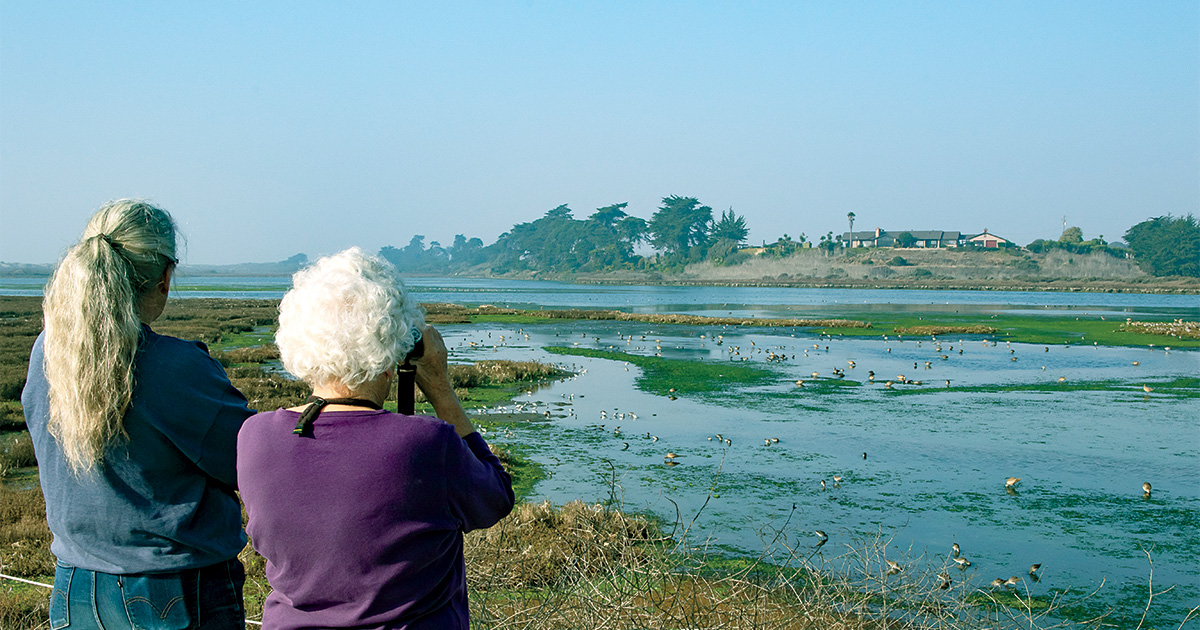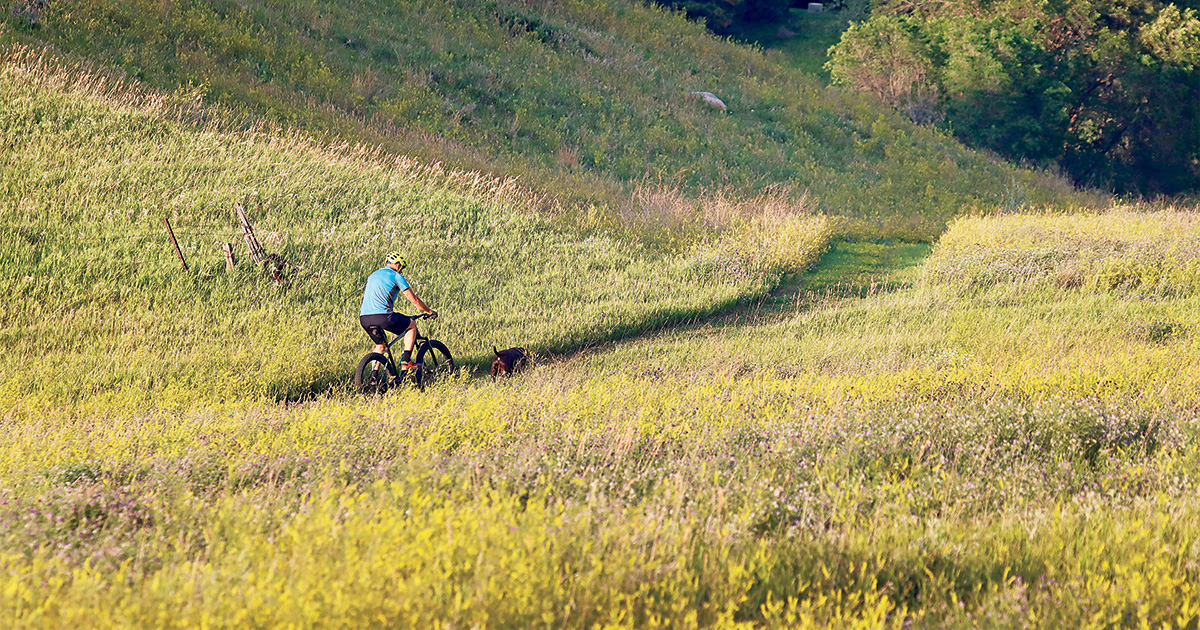A Place for Urban Wetlands
DU projects in populated areas can help build support for conservation
DU projects in populated areas can help build support for conservation
By Jennifer Boudart

Conserving wetlands in and around cities provides crucial habitat for wildlife and connects people with nature.
Studies have shown that Americans from all walks of life highly value nature, wildlife, and the outdoors, and they believe that time spent in nature supports their physical and emotional well-being. Yet Americans also report that it’s hard to make nature-based recreation part of their daily lives, especially if they live in urban areas that limit interaction with the natural world. People also tend to think that authentic natural landscapes only exist in remote places and that accessing them requires time, travel, and money.
One way to make nature more accessible, then, is to create more green spaces in urban areas that encourage meaningful connections with nature through education, hands-on exploration, and a sense of community involvement. To help meet this need, DU is contributing to a growing list of wetland restoration projects in urban spaces. In addition, DU has delivered restoration and enhancement work on more than 30 city-owned properties to provide ecosystem services such as water purification, floodwater storage, and aquifer recharge.
“People want outdoor opportunities close to their homes—within an hour’s drive,” says Dr. Steve Adair, DU’s chief scientist. “Traditionally, the work we’ve done has been in rural areas, and while hunters and bird-watchers travel to those places to pursue their hobbies, the average person living in a big city does not. The question is, how can we connect more people with wetlands and help them gain a better understanding and appreciation of their benefits?”
Adair says part of the answer is to bring wetlands to people by delivering DU conservation projects in populated areas within priority landscapes. For example, Bismarck, North Dakota, is located in the heart of DU’s highest-priority conservation area: the Prairie Pothole Region. The city is also home to DU’s Great Plains office. In late 2024, DU celebrated the opening of the 116-acre Clairmont Family Conservation Park, which is located next to DU’s office. The property was originally owned by William Clairmont, a longtime DU supporter and local land developer. Chris Hildebrandt, DU’s senior director of development for Montana, North Dakota, and Wyoming, recalls the conversation eight years ago when Clairmont mentioned that he had some property he had intended to develop for housing but was open to other ideas.
“We realized if we could turn the property into a conservation education park, it would be a great resource not only for the Bismarck-Mandan community, but for the Great Plains office to utilize as a living classroom,” Hildebrandt recalls. “People could come learn about wetlands and the prairies of North Dakota without having to go an hour outside of town.”
Clairmont liked the idea of creating a park that could serve as a legacy for his family, which has always had a great appreciation for nature. DU purchased the property through a bargain sale with support from the American Foundation for Wildlife and raised additional funding for habitat work. DU’s engineering team oversaw the restoration of two wetlands as well as riparian vegetation and trees. A system of hiking, biking, and multi-use trails with educational signage was developed in partnership with the Bismarck Parks and Recreation District, which now owns and manages the property. In addition, a 15-acre area is being restored to native mixed-grass prairie to serve as an example of the region’s native grassland ecosystem.

Many DU projects provide opportunities for people to enjoy hiking, biking, and other forms of outdoor recreation.
Public involvement was encouraged from the beginning, Hildebrandt says. Town hall meetings were held to address residents’ questions about a wide range of issues, from concerns about flooding and hours of operation to accessibility and traffic management. Going forward, Hildebrandt says, an outreach program is being developed to focus on educational opportunities for local schools. In the meantime, he and other DU staff regularly visit the park, where they’ve observed ducks, wild turkeys, pheasants, various species of songbirds, and other wildlife.
Moving west, DU recently completed another high-profile wetland restoration project, in this case on California’s San Francisco Bay. It doesn’t get more urban than this highly developed landscape, which is home to 7.7 million people spread across nine counties. San Francisco Bay also happens to be one of the highest-priority habitats for nonbreeding waterfowl in the Pacific Flyway. Unfortunately, roughly 90 percent of the bay’s historic wetlands have been lost since the 1800s.
Since 2013, DU has been a major partner in the largest tidal wetland restoration effort on the West Coast, known as the South Bay Salt Pond Restoration Project. This conservation partnership aims to restore more than 15,000 acres of industrial salt ponds to wetlands, expand public recreation opportunities, and provide flood risk management. The latest phase of this effort was recently completed on Don Edwards San Francisco Bay National Wildlife Refuge. Known as Ravenswood, the $13 million, 630-acre project engaged nearly a dozen city, state, and federal partners over 10 years of planning, design, and construction. DU engineers and biologists worked with these partners to restore tidal wetlands and adjacent uplands and to enhance existing managed ponds. Key objectives included maintaining or improving existing levels of flood protection infrastructure and enhancing public recreation opportunities by adding new bayfront access and developing 2,700 feet of hiking trails that connect to other trail systems. A new pedestrian bridge was funded by Meta to connect the restored wetlands to its headquarters next door. Informational signage and a visitor kiosk were installed in cooperation with Tribal partner the Association of Ramaytush Ohlone.
“Completing this urban project was extremely complex,” says Renee Spenst, DU’s regional biologist for San Francisco Bay and the California coast. Spenst says several hundred thousand cubic yards of soil had to be brought in to improve levees and create a broad habitat transition zone on this highly urbanized landscape. Moreover, buffers had to be developed around areas being used by nesting western snowy plovers and Ridgway’s rails.
Spenst notes that DU engaged many members of the public, including volunteers from Save the Bay, who helped plant native vegetation on the habitat transition zones. She says the public response has been very positive, and she feels that Ravenswood will serve as a flagship project for DU along the West Coast. “I can’t imagine a site that has greater exposure for DU both in terms of the habitat benefits that it provides and the number of people who will get out there and use it on a daily basis,” Spenst says.
Across the country, DU’s urban projects are connecting communities with nature, restoring critical habitat for waterfowl and other wildlife, and delivering additional public benefits. In doing so, they’re also drawing new partners and supporters to DU’s mission.
“It’s fascinating to see all the partners who rally around these types of projects, from municipal governments and park systems to people who are advocates for hiking and walking trails,” Adair says. “And we’re already seeing people who have never contributed to DU before step up to support us in response to these projects.”
Ducks Unlimited uses cookies to enhance your browsing experience, optimize site functionality, analyze traffic, and deliver personalized advertising through third parties. By continuing to use this site, you agree to our use of cookies. View Privacy Policy